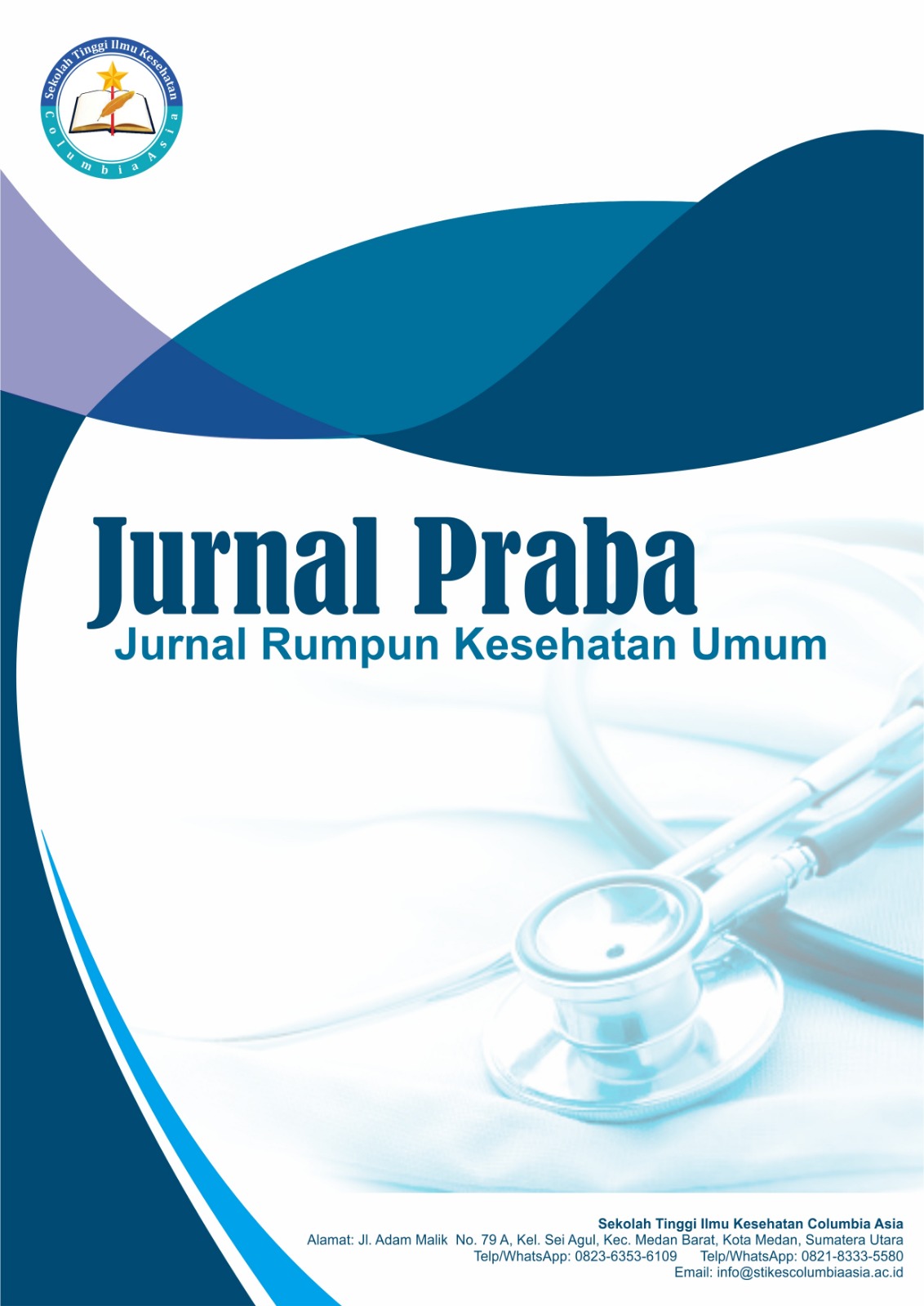Survey Status Gizi Siswa-Siswi SD Negeri 1 Tataaran II Kecamatan Tondano Selatan Tahun 2025 Kabupaten Minahasa
DOI:
https://doi.org/10.62027/praba.v3i2.414Keywords:
Nutritional statusAbstract
Nutritional status is the body's condition as a result of the utilization, absorption, and use of food. One of the health and social problems Indonesia is facing is the low nutritional status of its people. Nutrition deficiencies in young students will hinder mental development and brain intelligence in the future. The purpose of this study was to obtain an overview of the nutritional status of students at SD Negeri 1 Tataaran II, South Tondano District, Minahasa Regency.This research uses a descriptive survey. The population of this research are fourth and fifth grade students at Sekolah Dasar Negeri 1 Tataaran II, South Tondano District, totaling 40 students. The sampling technique used was a total population sampling, thus the sample population was 40 students. The instruments used in this study were a weighing scale, anthropometry equipment, and a list of the students’ names. Based on the research results, it was found that the nutritional status based on weight-for-age tended to be good, with 27 students (67.5%) falling into this category. The nutritional status based on height-for-age tended to be normal, with 27 students (67.5%) also in this category, and the nutritional status based on weight-for- height tended to be good, with 27 students (67.5%). In conclusion, the nutritional status of students at SD Negeri 1 Tataaran II, South Tondano District, tends to be sufficient and they generally have a good nutritional status. It is recommended that, to improve nutritional status at the household level, families should consume a diverse and balanced nutritious diet. The school, in collaboration with the health department or community health center, should routinely monitor the nutritional status of students
Nutritional status is the body's condition as a result of the utilization, absorption, and use of food. One of the health and social problems Indonesia is facing is the low nutritional status of its people. Nutrition deficiencies in young students will hinder mental development and brain intelligence in the future. The purpose of this study was to obtain an overview of the nutritional status of students at SD Negeri 1 Tataaran II, South Tondano District, Minahasa Regency.This research uses a descriptive survey. The population of this research are fourth and fifth grade students at Sekolah Dasar Negeri 1 Tataaran II, South Tondano District, totaling 40 students. The sampling technique used was a total population sampling, thus the sample population was 40 students. The instruments used in this study were a weighing scale, anthropometry equipment, and a list of the students’ names. Based on the research results, it was found that the nutritional status based on weight-for-age tended to be good, with 27 students (67.5%) falling into this category. The nutritional status based on height-for-age tended to be normal, with 27 students (67.5%) also in this category, and the nutritional status based on weight-for- height tended to be good, with 27 students (67.5%). In conclusion, the nutritional status of students at SD Negeri 1 Tataaran II, South Tondano District, tends to be sufficient and they generally have a good nutritional status. It is recommended that, to improve nutritional status at the household level, families should consume a diverse and balanced nutritious diet. The school, in collaboration with the health department or community health center, should routinely monitor the nutritional status of students
References
Achmad Djaini Sediaoetama. 1993. Ilmu Gizi. Jakarta. Penerbit Dian Rakyat.
Adi Darwnsa. 2010. Hubungan Faktor Sosial Ekonomi dengan Status Gizi Balita di Kelurahan Rappocini Kecamatan Rappocini Makassar Tahun2010. FIKES : UIN Alauddin Makassar.
Ali Khomsan. 2003. Pangan dan Gizi untuk Kesehatan. . Jakarta. PT Raja Grafindo Persada.
Almatsier, Sunita. 2001. Prinsip Dasar Ilmu Gizi. Jakarta : PT. Gramedia Pustaka Utama. Arisman. 2010. Gizi Dalam Daur Kehidupan. Jakarta : EGC
Azwar, Bahar. 2005. Fiqih Kesehatan Dari Ibadah, Pengobatan Sampai Penyakit Flu Burung. Jakarta : Qultum Media.
Departeman Agama RI. 1971. Al-Qur’an dan Terjemahannya. Jakarta : Departeman Agama RI.
Departemen Kesehatan RI. SKRT 1995. Badan Penelitian dan Pengembangan Kesehatan Departemen Kesehatan RI. 1997.
Departemen Kesehatan RI. 2000. Pedoman Umum Gizi Seimbang ( Panduan Untuk Petugas ). Jakarta: Departemen Kesehatan.
Departemen Kesehatan RI. 2002. Panduan Makan untuk Hidup Sehat. Jakarta : Depkes RI.
Departemen Kesehatan RI. 2004. Kecenderungan Masalah Gizi dan Tantangan di Masa Datang. Jakarta : Depkes RI.
Depkes RI. 2002. Pemantauan Pertumbuhan Balita. Jakarta: Direktorat Bina Gizi Masyarakat.
Departemen gizi dan kesehatan masyarakat FKM UI. 2007. Gizi dan Kesehatan Masyarakat. Jakarta : PT. Raja Grafindo Persada.
Departemen.. 2004. Analisis Situasi Dan Kesehatan Masyarakat. Jakarta : Depkes RI.
Hadi, Hamam. 2005. Beban Ganda Masalah Gizi dan Implikasinya terhadap Kebijakan Pembangunan Nasional. FK : UGM.
I Dewa Nyoman Supariasa. Bachtyar Bakri. Ibnu Fajar. 2002. Penilaian Status Gizi. Jakarta. Penerbit Buku Kedokteran. EGC.
Riskesdas. 2007. Laporan Provinsi Sulawesi Selatan (2007), Badan Penelitian dan Pengembangan Kesehatan Departemen Kesehatan, Republik Indonesia Desember 2008
Shihab, Quraish. 2002. Tafsir Al-Misbah : Pesan, Kesan dan Keserasian Al- Qur’an. Jakarta : Lentera Hati.
Soekidjo Notoatmodjo. 2002. Metodologi Penelitian Kesehatan. Jakarta. Penerbit Rineka Cipta.
Soekidjo Notoatmodjo. 2010. Metodologi Penelitian Kesehatan. Jakarta. Penerbit Rineka Cipta.
Suhardjo HR.1996. Peranan pertanian dalam Upaya Mengatasi Pangan dan Gizi. Institut Pertanian Bogor. Bumi Aksara.
Syekh M. Yusuf. 1980. Halal dan Haram dalam Pandangan Islam. The Holy Koran Pub. House, Beirut, Lebanon.
Unicef. 2002. Pedoman Hidup Sehat. Jakarta: Unic.
Downloads
Published
How to Cite
Issue
Section
License
Copyright (c) 2025 Jurnal Praba : Jurnal Rumpun Kesehatan Umum

This work is licensed under a Creative Commons Attribution-ShareAlike 4.0 International License.







